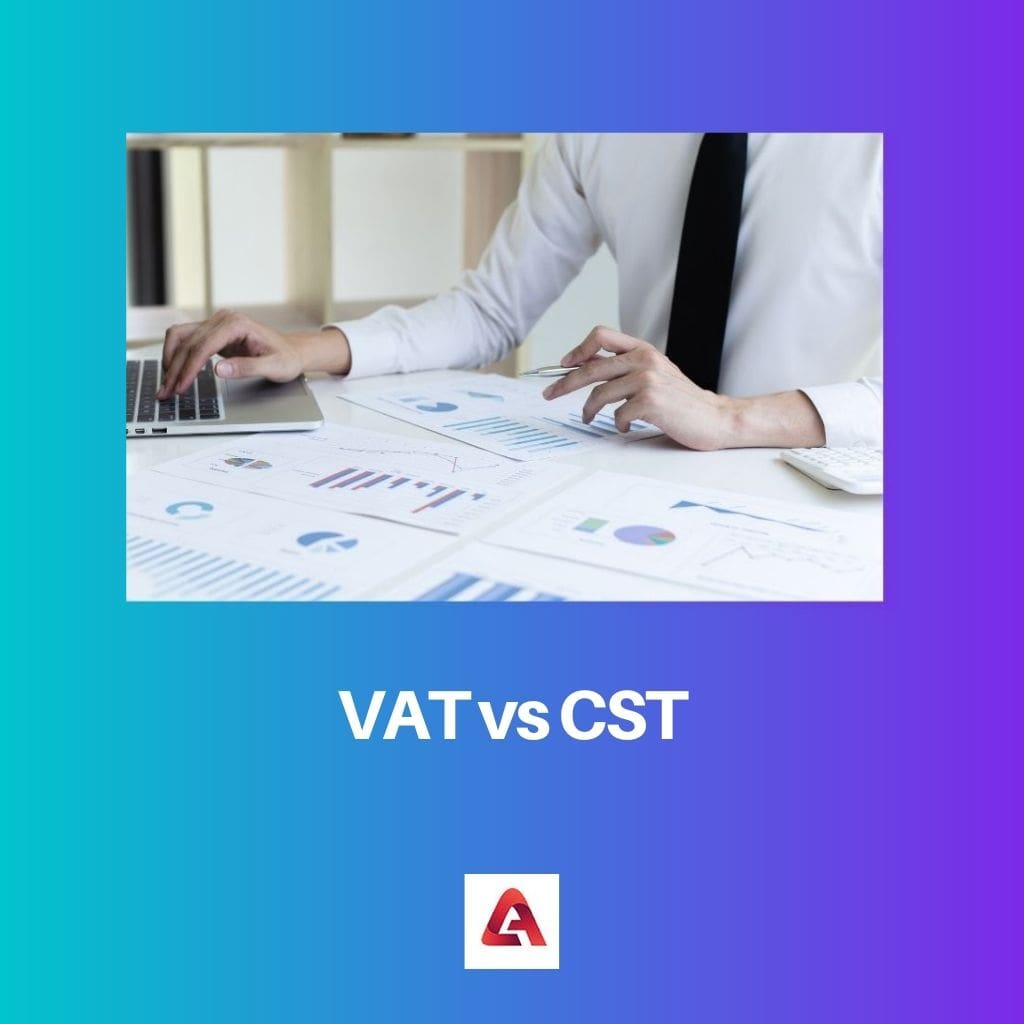Taxation is a complicated subject. Taxes are categorized into direct taxes and indirect taxes. Direct Tax is the tax people directly pay to the government, such as income tax.
There are multiple types of taxes in the indirect tax domain. However, VAT and CST form the central taxes, which most people will be familiar with.
Key Takeaways
- VAT (Value Added Tax) is a consumption tax levied on goods and services within a country or state’s jurisdiction, with tax paid at each stage of the supply chain.
- CST (Central Sales Tax) is a tax imposed on the sale of goods during interstate trade or commerce, collected by the seller and remitted to the government.
- Both VAT and CST are indirect taxes, but VAT is a state-level tax, while the central government levies CST in the context of interstate transactions.
VAT vs. CST
The difference between VAT and CST is that VAT is a type of indirect tax imposed at multiple production or distribution phases. At the same time, CST is an indirect tax levied on sales conducted between states, i.e., interstate sales.

However, the above is not the only difference. A comparison between both the terms on specific parameters can shed light on subtle aspects:
Comparison Table
| Parameter of Comparison | VAT | CST |
|---|---|---|
| Full-Form | Value Added Tax | Central Sales Tax |
| Stage of Production | Levied at each stage of production or distribution | CST is not charged on any steps in production or distribution. It is set on the final sale. |
| Concessions | Fewer concessions are available under VAT. There may be certain goods on which no VAT may be applicable. | There are concessions and exemptions available, both general and specific |
| Nature of Tax | Multiple-points tax as the tax is levied on multiple stages of production or distribution | One-point tax as it is only levied on final sales |
| Applicable Law | Value Added Tax Act, 2005, and associated rules and procedures established under the same govern the VAT system in India | The Central Sales Tax Act 1956 and associated rules and procedures established under the same govern the CST system in India |
| Input Tax Credit | There is a facility of Input Tax credit on VAT | There is no facility for Input Tax credit on CST |
| Complexity | VAT is a complex tax levied on multiple stages and with different rates | Less complicated because it is only set on the final sale |
| Scope for Double Taxation | Not possible | Possible |
| Scope for tax evasion | Fewer chances | More chances |
| Prevalence | Applicability since recent times | Applicable for many decades |
| Replacement | VAT has replaced CST in recent times | CST has been replaced with VAT |
What is VAT?
VAT means Value-Added Tax. VAT is a type of indirect tax or consumption tax. VAT is called an indirect tax because it is indirectly paid by the end customer when procuring goods or services from manufacturers or retailers. VAT is levied at various phases of production or distribution.
Again, the rates may differ from one State to another. VAT applies to all goods and services, whether developed in India or sourced from outside.
VAT registration is compulsory, depending on the threshold load and other factors. Non-registration under VAT is an offense under the law, and governmental authorities can impose certain fines or sanctions.
VAT is payable to the government on specified dates (monthly) as per the rules in force, and certain returns may also need to be filed.
Various methods can calculate VAT, but VAT is a very complex area, and the VAT phenomenon is relatively new from the Indian perspective.

What is CST?
CST means Central Sales Tax. CST is an indirect tax. CST is a type of tax being levied on interstate sales. Although CST applies to interstate sales, the State Government can also set CST on sales conducted within the State.
CST applies to all goods and services, whether developed in India or procured from outside. CST collected is payable on due dates (monthly), and certain returns must be filed.
CST has been prevalent in India for a long time. However, CST is fraught with multiple problems such as cascading effect (double taxation) and the possibility of tax evasion.
The Central Sales Tax 1956 and related rules in India specify the applicable provisions for CST. Many states may also have their own sales tax laws.

Main Differences Between VAT and CST
- VAT has the mechanism of Input Tax credit. CST does not have any methods of Input Tax Credit.
- VAT does not or has fewer chances of tax evasion or double taxation. CST is fraught with problems with tax evasion and double taxation.

- https://mpra.ub.uni-muenchen.de/206/1/MPRA_paper_206.pdf
- https://www.sciencedirect.com/science/article/pii/S0377221703007409

I found this piece to be quite amusing. Who knew tax comparisons could be entertaining?
It’s always nice to add a touch of humor to traditionally dull topics!
The incorporation of engaging content in articles like these makes reading them much more enjoyable.
The author seems to have a bias favoring VAT over CST. Can anyone else see this subtle influence?
The explanations are incredibly informative, but they tend to oversimplify complex taxation systems.
The details provided in this article are enlightening. I appreciate the effort put into simplifying complex tax concepts.
This article did a fantastic job of explaining the differences between VAT and CST. I feel like I understand these topics much better now!
I completely agree, Ksaunders. The information was presented in a clear and concise manner.
I have some concerns about the implementation process of VAT and CST. Are there systems in place to prevent misuse or fraud?
The comparison table is especially helpful in understanding the nuances between VAT and CST.
This article provided a helpful overview of VAT and CST. The references at the end ensure credibility and reliability of the information.
The comparison between VAT and CST was interesting, but it failed to address the impact of these taxes on low-income individuals.
Unfortunately, this article left me more confused about VAT and CST than I was before. It’s just too much to process.